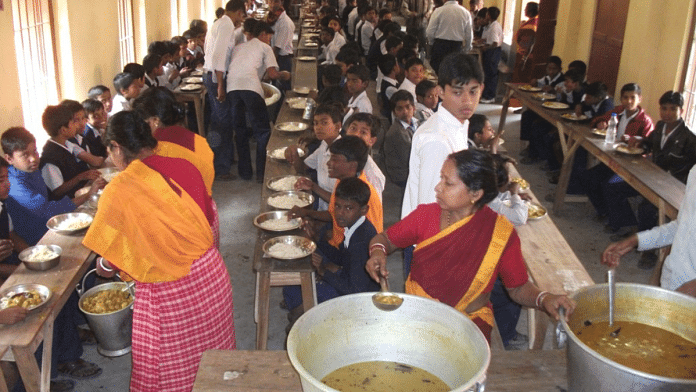New Delhi: High enrollment figures on paper, but many students don’t even turn up for examinations, while others study in private schools; money meant for purchase of pulses and vegetables being spent, yet 50,000 metric tonnes and above of rice remain unutilised every year.
These are among the alleged discrepancies in the implementation of the midday meal programme that a team constituted by the Union government came across in West Bengal, which now stands to receive Rs 180 crore less than what it sought as central assistance under the scheme in 2023-24.
In its final report, seen by ThePrint, the Joint Review Mission (JRM), which comprised officials of the Ministry of Education as well as the state government, observed that many students enrolled in government schools “continue to study in private schools” and that foodgrains have not been utilised “in proportion to the number of students covered as claimed by the state”.
On 15 May, in a meeting attended by officials of the Centre and the state, West Bengal sought Rs 1,446.73 crore as central assistance for providing meals to 1,16,15,992 students in 2023-24. However, the Centre pointed out that district-level reports suggest that only 84 percent (1,01,35,163) of enrolled students were covered under the scheme in 2022-23.
According to official records of the meeting, the state government “admitted that the claimed coverage of students (96 percent) is on the higher side” and that it is taking measures “to revisit the reported figures at various levels”. “Thus, the state’s proposal of central assistance of Rs 1,446.73 crore has been reduced by Rs 179.65 crore to Rs 1,267.08 crore,” the records state.
West Bengal had received Rs 1,446.73 crore in central assistance under the scheme in 2022-23.
The JRM, which was led by Prof. Anuradha Dutta of the Department of Food and Nutrition at the GB Pant University of Agriculture and Technology, arrived at its conclusion primarily based on a “serious mismatch” on two counts.
First, it found, during its visit between 29 January and 7 February, that contrary to the state’s claim that nearly 96 per cent of the enrolled students in Classes I-VIII were availing hot cooked meals under the scheme, many children were pursuing studies in private schools.
“The team observed that in almost all the visited schools, some enrolled students have not even appeared for examinations, in some cases this number was more than 30 students. When enquired about this, the teachers informed that many students are enrolled in government schools, however, they continue to study in private schools which, again, is a very serious issue and requires in-depth analysis,” according to the report.
Second, it pointed out, the utilisation of food grains (rice in the case of West Bengal) and material cost is not proportionate. Material cost — Rs 5.45 per child for students in Class I-V and Rs 8.17 for students in Class VI-VIII — goes into purchase of pulses, vegetables, oil, condiments, and cooking fuel, it added.
“Contrary to under utilisation of foodgrains, the utilisation of material cost is almost 100 per cent every year. This offers a real contradiction here, since utilisation of material cost and utilisation of foodgrains go in sync with the number of children covered, ideally the utilisation of these two components should match. However, as is evident from the data, there is a serious mismatch in utilisation of foodgrains and material cost vis-a-vis coverage of children,” the report states.
When contacted, a West Bengal government official said that the report was not signed by the representative of the state in the team as it was not shown to him before finalising.
On 15 May when the Centre cut the allocation by Rs 180 crore for the scheme, West Bengal Education Minister Bratya Basu had tweeted that “the hype created around the report of the Joint Review Committee was deliberately created for political gains”.
— Bratya Basu (@basu_bratya) May 15, 2023
Under the midday meal scheme, which officially covers 12.21 crore students in pre-primary classes and Classes 1-8 across states and Union Territories, the cost of foodgrains is borne entirely by the Centre. Other components, including cooking cost, are split in a 60:40 ratio between the Union government and the states and Union Territories with legislatures, and 90:10 with the Northeastern states, Jammu and Kashmir, Himachal Pradesh, and Uttarakhand.
(Edited by Tony Rai)



